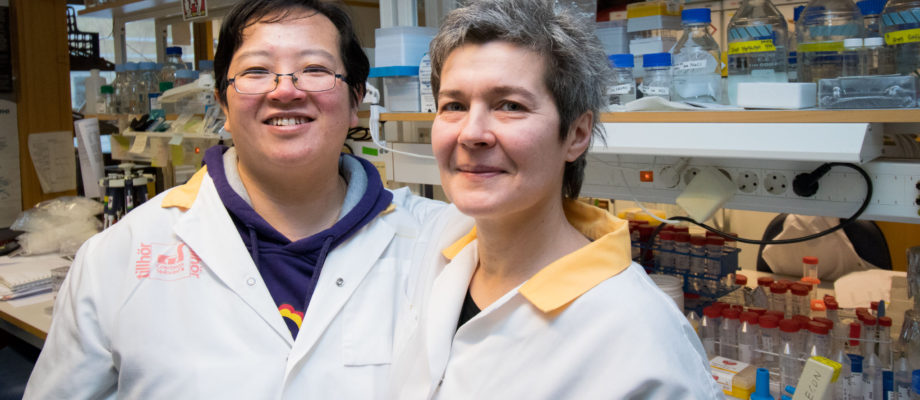NEW STUDY. In a newly published article in the journal Nature, researchers at Sahlgrenska Academy identify two proteins that can put cells’ energy metabolism in a saving mode. This involves transcription factors FOXK1 and FOXK2, which have been shown to regulate the production of the lactate energy source.
Under normal circumstances, cells obtain energy from adenosine triphosphate (ATP) molecules produced by the mitochondria inside the cells. In recent years studies have demonstrated that lactate, a form of lactic acid, also serves as a supplementary energy source. Researchers have previously shown that cells can also produce lactate as an energy source through cell division in fetuses and tumors and in the case of diabetes.
Two factors stood out
The work that has now been published in Nature shows that transcription factors FOXK1 and FOXK2 increase lactate levels by accelerating the enzymatic cell machinery that underlies the production of lactate. For Valentina Sukonina and Haixia Ma, research colleagues at the Department of Medical Biochemistry and Cell Biology and co-first authors of the article, the publication in Nature culminates many years of work.

“When I arrived at Sahlgrenska Academy, I began screening for transcription factors expressed in cell cultures from adipose tissue, and these two factors stood out,” Sukonina explains. “When the transcription factors were overexpressed, we could see that the absorption of glucose dramatically increased in the cultured cells. That perplexed us, and we wanted to know more about the signal path and mechanisms behind the discovery.”
An important finding in the study is that FOXK1 and FOXK2 produce this result in many different organs and tissues.

“We created a genetically modified mouse that lacked the transcription factors and compared it with normal wild mice,” says Haixia Ma, an expert on a relatively new and rapid method of creating transgenic mice, among other things. “By following glucose with a radioactive marker in the mice, we could see that mice lacking the transcription factors had significantly reduced lactate production compared to the wild type of mice.”
Used by many types of cells
This basic research increases our knowledge of cells’ energy metabolism and could be significant in diseases such as cancer and diabetes.
“By studying the mechanisms of cellular metabolism, we acquire basic knowledge that perhaps can ultimately lead to ways to affect metabolism by, for example, identifying new drug targets,” says Sukonina. “Since we also see that the regulating mechanism we have now identified is used by a number of different cell types, we need to first know more about what is happening in the various cells and organs if we affect FOXK1 and FOXK2.”
The whole team has contributed
Many researchers made important contributions to the results now published in Nature. Valentina Sukonina and Haixia Ma single out Santhilal Subhash, a bioinformatician in Chandrasekhar Kanduri’s group, who helped to visualize the signal pathways regulated by FOXK1 and FOXK2. Stefano Bartesaghi, who works at AstraZeneca in London, also made crucial contributions through his expertise in an advanced method of analysis called seahorse, which uses various reagents to follow in real time the processes in which a cell is involved. In addition, almost all the colleagues in Sukonina’s and Ma’s research team contributed to the project. Professor Sven Enerbäck, who heads the team and conducts research on brown adipose tissue, was the person who realized that the work attained such a high level that it could qualify for Nature.

“This project began as a continuation of our studies of brown adipose tissue to find out how brown adipose cells regulate the absorption and metabolism of nutrients such as fatty acids and glucose,” says Enerbäck. “This led to our discovery of these regulatory mechanisms, which seem to be used in many different types of cells, not just the brown adipose ones.”
The team is currently investigating how FOXK1 and FOXK2 regulate lactate production in different cell types and tissues in more detail. The researchers are also interested in other transcription factors that may play a role in energy metabolism in cells.
You can read the article on how FOXK1 and FOXK2 regulate aerobic glycolysis here: https://www.nature.com/articles/s41586-019-0900-5
Title: FOXK1 and FOXK2 regulate aerobic glycolysis
Publication: Nature
Authors: Valentina Sukonina, Haixia Ma, Wei Zhang, Stefano Bartesaghi, Santhilal Subhash, Mikael Hedlind, Håvard Foyn, Matthias J. Betz, Daniel Nilsson, Martin E. Lindell, Jennifer Neumann, Saskia Haufs-Brusberg, Henrik Palmgren, Tanmoy Mondal, Muheeb Beg, Mark P. Jedrychowski, Kjetil Taskén, Alexander Pfeifer, Xiao-Rong Peng, Chandrasekhar Kanduri & Sven Enerbäck.
TEXT AND PHOTO: ELIN LINDSTRÖM CLAESSEN











